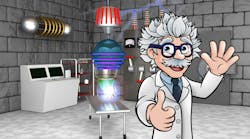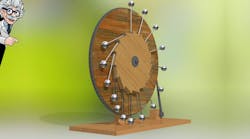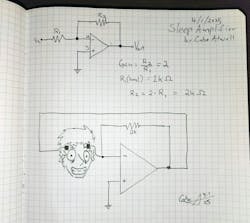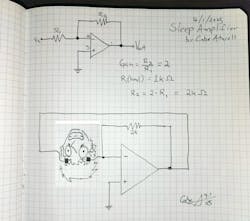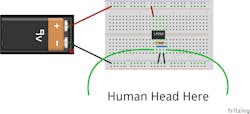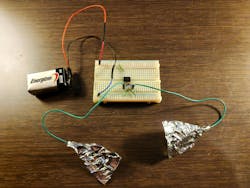Hacking a Better Night’s Sleep: A DIY Project Guide
What you’ll learn:
- How to hack your way to a better night’s sleep.
- How I design projects from start to finish.
- Some further considerations for the project.
I only get four hours of sleep at night. Am I the only one here dealing with this? I’m up late doing projects or writing, only because I can’t stay asleep. I read that one in 10 people suffer from chronic insomnia. One in three face it occasionally, too. The older you get, the more often this is a problem. What do engineers do in the face of a problem? SOLVE IT.
I thought, what if I could hack sleep and stay asleep?
Circuit Design
Here’s my concept: The brain is an electrical signal generator; what if I apply a feedback amplifier to the brain’s sleeping condition? If I can only stay asleep for four hours, if I double the brain’s signal, I’ll get twice the sleep time. That’s the ever-elusive eight hours!
>>More April 1st Mayhem
The concept seems so simple that people have never tried it. They ask, “How could it possibly work?” or “Don’t be ridiculous, it wouldn’t work.” And what did these naysayers NOT do? Actually try it. So lazy!
The circuit is simple, a standard amplifier circuit (Fig. 1).
You all should be familiar with this equation: Gain = R2/R1. The human brain, on average, is between 500 to 1000 Ω in relative resistance. That’s our R1. I chose to lean on the larger side and go with 1 kΩ. That means we need a 2-kΩ resistor for R2.
Replace R1 with your head (Fig. 2). Then, the output is applied to the system input.
For VCC, I went with a 9-V battery. Any smoke detector will have one. They’re everywhere!
Breadboard Digital Design
The breadboard layout is extremely simple (Fig. 3).
Breadboard Physical Build
The leads, where you collect the cranium, need a way of making a strong contact. So, in the physical build, I improvised to great success (Fig. 4).
The foil contacts are critical. Making sure they have solid contact with your head is key. Duct tape works great here, but beware of removing the tape later.
BOM for your reference:
- LM358 dual op-amp IC (upgrade the project for couples?)
- One 2-kΩ resistor
- Project and breadboard wires
- Half+ breadboard
- 9-V battery adapter
- 9-V battery
Results
The first night, it didn’t work. Of course, I had a breadboard issue. What’s the thing you can always guarantee with a breadboard build? You’ll have a wire off somewhere. In this case, the output wire wasn’t connected to pin 2. I was thinking of an LM741.
I’m glad to share that, on the second night, it worked. But I woke up four days later! Still, I was so rested. For a while, I didn’t even care that I missed four days of work. I had a long breakfast that looked like something out of a 1980s commercial. Eggs, cereal, two waffles, pancake stack, toast, a glass of orange juice, a glass of milk, a glass of water, and a steaming hot coffee.
In fact, I still don’t care. I just woke up from another four days and look forward to the next four. By my calculations, I will turn a typical 365-day year, consisting of 260 workdays, into maybe 73 workdays. Awake one day, asleep four. I’ve hacked a better work-sleep balance. YOU’RE WELCOME.
But I’m running out of smoke detector 9-volts. So, all this is a moot point.
Read more April 1st articles
About the Author
Cabe Atwell
Technology Editor, Electronic Design
Cabe is a Technology Editor for Electronic Design.
Engineer, Machinist, Maker, Writer. A graduate Electrical Engineer actively plying his expertise in the industry and at his company, Gunhead. When not designing/building, he creates a steady torrent of projects and content in the media world. Many of his projects and articles are online at element14 & SolidSmack, industry-focused work at EETimes & EDN, and offbeat articles at Make Magazine. Currently, you can find him hosting webinars and contributing to Electronic Design and Machine Design.
Cabe is an electrical engineer, design consultant and author with 25 years’ experience. His most recent book is “Essential 555 IC: Design, Configure, and Create Clever Circuits”
Cabe writes the Engineering on Friday blog on Electronic Design.

